Ketchup to Magic Marker: Essential Stain Removal Guide for Kid’s T-Shirts
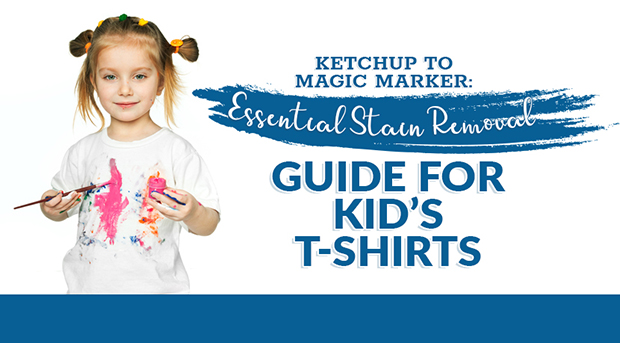
Childhood is among the happiest stages of life, and the messiest. It’s a fact of life that kids get dirty!
As your children play, create, explore and enjoy everything the world has to offer them, it is inevitable that, at some point, they will come home with a stain on their clothes.
The constant cycle of messes and stains can be trying even for the most patient of parents. By learning what type of stain removal product and process to use on which type of stain and fabric, you can get their clothes sparkling clean and send them back out into the world to get dirty all over again.
The Basic Principle of Stain Removal
There are a few basics of stain removal that apply, regardless of the type of stain you are removing.
It is essential to know the age of the stain, the length of time the item has been stained and the type of fabric or material you are removing the stain from. The stain removal process is very different for removing grass stains from a wool sock, than it is when eliminating butter stains from a cotton t-shirt.
There are typically two steps involved: lifting and laundering. Lifting consists of removing the staining material from the garment, while laundering usually uses soap, water and gentle agitation to remove whatever remains on the fabric.
The sooner you initiate the removal of the stain, the more likely it is you can get it out of the fabric. The more time a stain has to soak into the fabric and set, the more stubborn the stain tends to become.
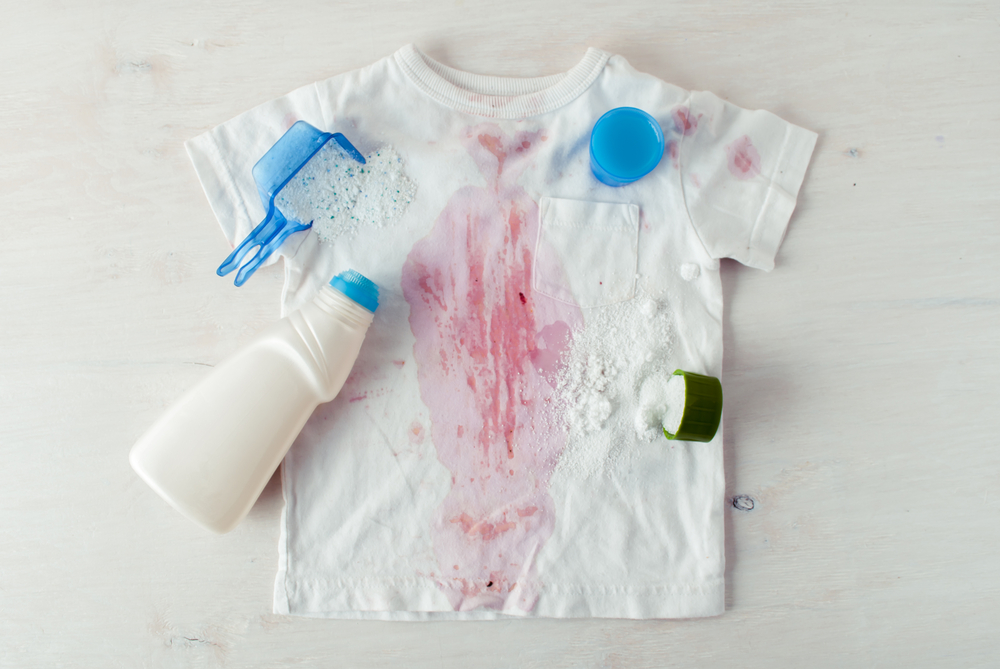
What Is Spot Testing and Why Should You Do It?
An important consideration before using any stain removal product is to “spot test” the product on an inconspicuous area of the garment before applying it to the stain. This applies even more if the stain is in plain sight while wearing the garment. Typically, a small spot on the inside of a seam on the back is used for testing.
The objective of spot testing is to prevent further damage or destruction of the garment. It is especially important when using a new cleaning product for the first time, specifically with delicate fabrics.
The Importance of Knowing the Type and Age of Stain You Are Removing
The type of material that has stained the fabric of your child’s clothing will determine how to proceed in removing it. Different materials have different properties, and what works for something oil-based will not work for something waxy, and so on.
Knowing how long the fabric has been stained is also useful. The age does not impact the type of treatment used, but it may impact the number of cycles of stain removal that you will have to attempt to remove the stain successfully. The longer the fabric has been stained, the more attempts it will take to remove it, or the longer the item should soak before rinsing.
Ketchup, Pasta Sauce and Other Red Food Stains
The first step to eliminating red food stains from a t-shirt is to use a utensil to lift off as much of the excess substance as possible. However, avoid dabbing or rubbing during this process, as this will cause the stain to worsen.
As soon as possible, remove the garment and run it under cold water. Soak it in a cool solution of water and dishwashing soap, and then rinse again if the stain is persistent. If the stain is still visible after this, apply a few drops of white vinegar, let the garment soak for 1-2 minutes, and then once again, run it under cold water until the water runs clear.
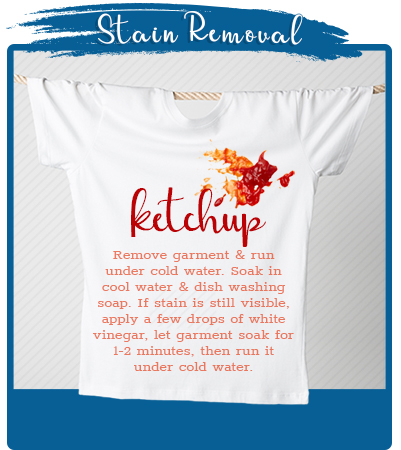
Marker, Pen and Other Ink
Scholarly youngsters may not notice a stray ink mark, but some types of ink stains are impossible to remove. However, others are less challenging.
For Magic marker or most felt-tip type markers, soak the fabric in a concentrated solution of laundry soap and cool water for at least five minutes. After this, run the stained area under cold water for several minutes. You may need to repeat this process several times to achieve the desired result.
Ballpoint pen ink is considerably more difficult to remove. The best way is to use rubbing alcohol to blot out the stain, though you may be unable to remove it entirely using this method.
Another method is to use alcohol wipes to rub the stain out. It is ideal to launder the garment in question following this process, though be careful to wash it alone to avoid inadvertently staining the other items sharing the washing machine.
Milk, Dairy, Ice Cream or Eggs
Eggs and dairy products are all protein-based stains. With this type of stain, you must use an enzyme soak — available in the cleaning aisle of any major retailer — to soak the stained area before laundering.
The length of time the stained item will need to be soaked depends on the age of the stain, with older stains taking up to two hours to soak in the enzyme solution.
The role of the enzyme soak is to break down the proteins from the staining substance that have bound to the fibers of the fabric, making it easier to remove.
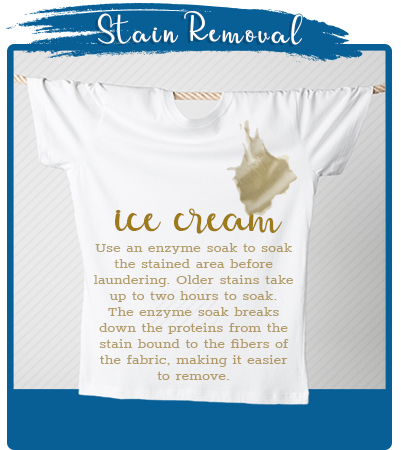
Butter, Mayonnaise or Other Oil-Based Products
Almost anyone who has enjoyed a tub of extra buttery popcorn at the movie theatre knows the pain of removing a butter stain from their clothing the next day. Thankfully, the process for eliminating butter- and oil-based stains is straightforward and is the same for any oily substance that has stained your child’s clothes.
For best results, the removal of stained oil-based products requires pre-treatment with a commercially available stain remover. These are sold at most major grocery and department stores in the cleaning section.
For the best results, follow the instructions printed on the side of the stain remover product. Following this, wash the garment in hot water. Since hotter water generally means better results, use the hottest water temperature listed as safe on the garment label.
Chewing Gum
The secret to removing stuck and stained gum is simple: cold temperatures!
To remove gum stains, apply ice cubes to the affected area or place the entire garment in the freezer for an hour or two. After this, use a clean butter knife to scrape off any visible gum on the surface of the item.
Once you have removed the gum, it is best to apply a commercial stain remover using the instructions listed on the bottle, and then rinse out the item and wash it in the washer and dry as you normally would.
Chocolate
This sweet treat is simple to remove from clothes. Use a spoon to remove excess chocolate. Then massage liquid laundry detergent into the stain, letting it soak in for at least five minutes. Finally, wash it with all-fabric bleach, per the garment’s instructions.
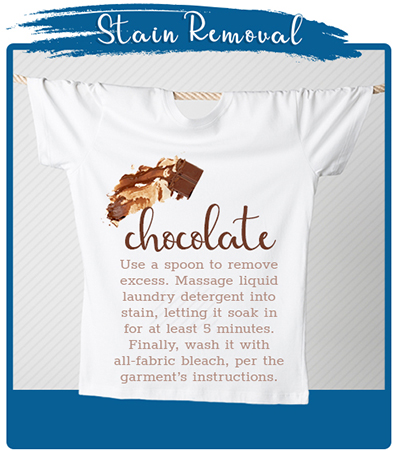
Dirt, Mud or Puddle Water
Removing dirt and mud from children’s clothing is simple.
The first step is to brush or scrape off any visible dirt on the surface of the clothing. Ask your child to do this before coming into the house, if possible.
Then soak the item in a diluted solution of laundry soap and water. For especially old or aggressive mud stains, rub laundry detergent directly onto the stained area using a soft-bristled brush.
Then rinse the garment in lukewarm water and launder, as per your usual routine.
Elmer’s Glue
If your little Picasso gets a splash of glue on his outfit in art class, simply scrape off the excess. Then pre-treat the fabric with a stain remover and wash in the hottest temperature permitted on the garment’s tag.
Paint
If your kiddo is especially creative — or just likes to get their fingers busy in the finger paint at daycare — you will likely have to remove paint stains from their clothing.
Determine if the paint is oil- or water-based.
Oil-based paint is the more difficult to get out of clothing. Apply turpentine to the stain. After rinsing the solvent out with room temperature water, pre-treat by applying laundry detergent with a soft-bristled brush to the stained area, rinsing this and then laundering, per your normal routine.
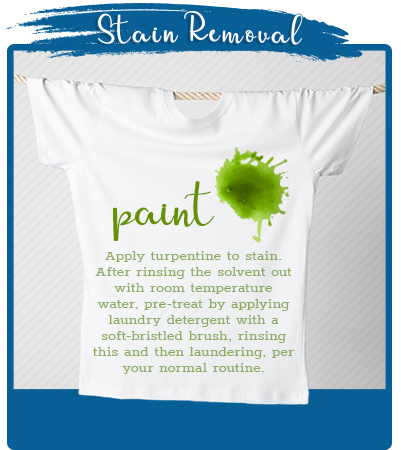
Grass
Grass stains are the bane of every soccer parents’ existence. However, they are surprisingly simple to remove. Although you can easily use a commercial stain remover, it is just as easy to mix 1/3 cup white vinegar to 2/3 cup plain water and apply liberally to the stained area using a sprayer bottle.
Use a toothbrush or nail brush to rub this mixture into the stain in a circular motion. Following this, rinse in cold water and launder the garment as you normally would.
Dirt, mud and grass stains often go hand-in-hand. In this case, first wait for the mud to dry and then remove any noticeable dirt or dried mud, before treating the grass stains. Finally, treat any remaining mud stains with a prewash stain remover before laundering.
Blood
When you’re a child, having a scraped elbow or other boo-boo is bad enough, and is made much worse when a favorite t-shirt is stained in the process.
For a fresh blood stain, simply soak in cold water and then launder in cold water as well. Never use hot water, as this causes fresh blood stains to set into most fabrics.
For old blood stains, follow the instructions for dairy products. Blood, after all, contains a great deal of protein and is best removed with an enzyme soak for this reason.
Bleach is also helpful for new and old blood stains and can be added when you launder the garment.
Stain Removal for Cotton
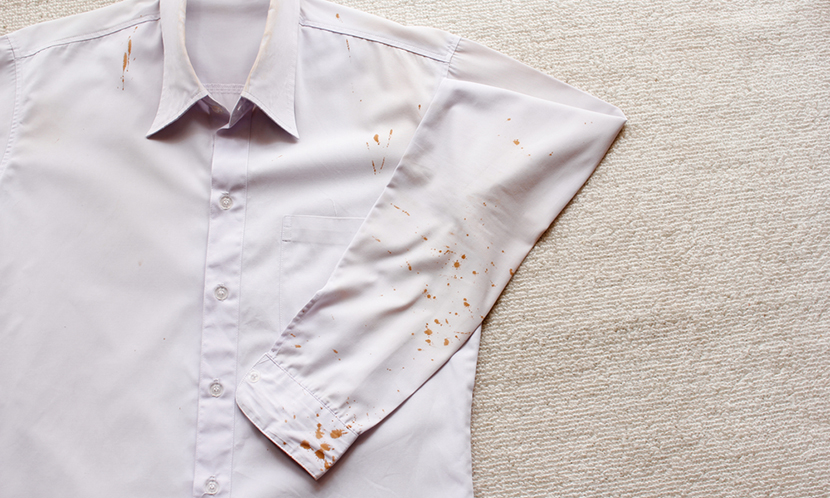
Plain 100 percent cotton is by far the most common t-shirt material. Kids t shirts are so commonly made from cotton because it is a comfortable material, inexpensive to produce and feel very natural on the skin.
The tips for removing stains made by the substances above are all appropriate for use with cotton. The only additional consideration for removing stains from cotton t-shirts is that if they are white in color, a bleach solution can be applied to the stained area or to the entire garment to facilitate stain removal.
Cotton will typically experience minimal shrinkage in hot water the first time this is done.
Stain Removal for Polyester and Polyester Blends
There is good news for polyester lovers: since polyester is among the least absorbent of all material types, it is relatively difficult to stain items made from this fabric.
Kids sweatshirts are made from a polyester-based fleece and are the perfect warm and cozy garment to send your child to school in during the chilly autumn months. However, if your child has managed to stain a polyester t-shirt, not all is lost! The simplest way to remove a new stain from polyester is to soak the entire garment in a vinegar solution consisting of a couple of tablespoons of white vinegar in a small basin of cool water.
After soaking for 30-60 minutes, remove and launder as usual. Repeat the laundering cycle using a scented laundry detergent if the smell of vinegar persists or is bothersome.
Stain Removal for Rayon
Though less popular than cotton, rayon is still a standard fabric used in children’s clothing. Kids polo shirts are commonly made from rayon due to its comfort, breathability, and ease of wearing. To remove a stain from rayon simply blot up any excess with a dry clean cloth. Pre-soak the stain in a solution of warm water, one-half teaspoon of dishwashing liquid and a tablespoon of vinegar for 15 minutes, rinse and use a sponge and rubbing alcohol to blot up any remaining stain before laundering.
Stain Removal for Wool

Wool is a standard material used in the construction of kid’s sweaters due to its thermo-regulating properties, as it helps children keep warm when playing outside in the cold. However, it is occasionally used in children’s t-shirts as well, as it makes an excellent base layer for activities such as skiing, hiking and skating.
An essential consideration for laundering wool is that is cannot safely be laundered at high temperatures because it shrinks when heat is applied to it. For this reason, any stain removal instructions that contain the application of heat or laundering in hot water must be disregarded with wool items, and warm water can be used instead.
Final Thoughts
So, the next time your child’s sticky lunch ends up in his lap, or her favorite condiment slides off her burger onto her shirt, use this guide and a few supplies you already have at home to salvage their favorite article of clothing.


